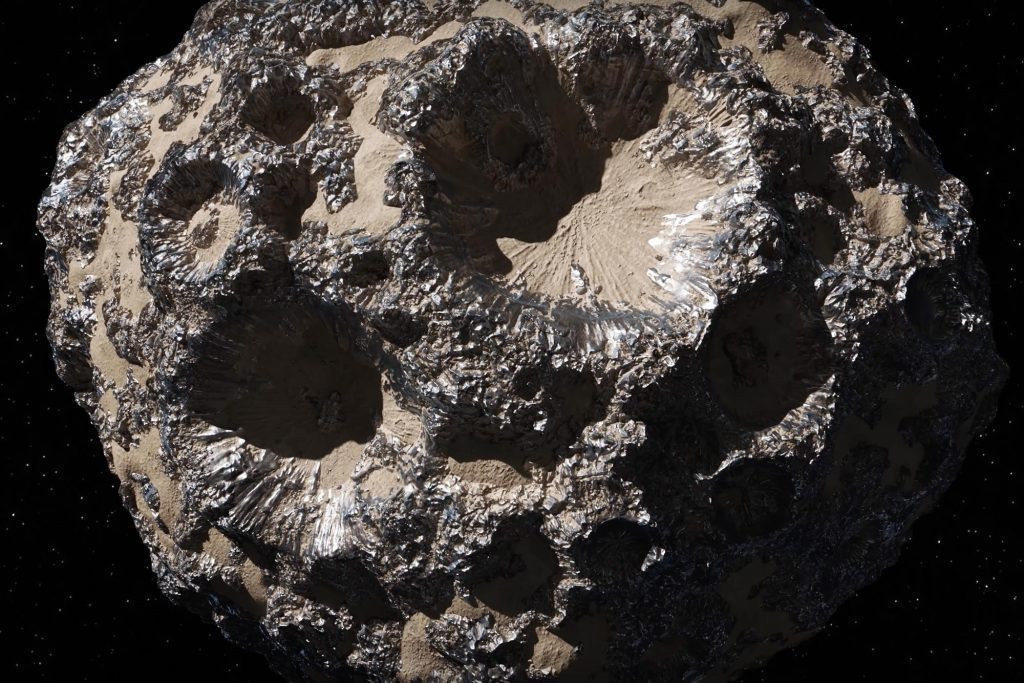
Los astrónomos del MIT y otros lugares han mapeado la composición del asteroide Psyche, revelando una superficie de metal, arena y roca. Crédito: captura de pantalla de la NASA
La variada superficie del asteroide Psyche sugiere una historia dinámica, que puede incluir erupciones minerales, efectos de sacudidas de asteroides y la falta de un manto rocoso.
Después en este añoY el[{» attribute=»»>NASA is set to launch a probe the size of a tennis court to the asteroid belt, a region between the orbits of Mars and Jupiter where remnants of the early solar system orbit the sun. Once within the asteroid belt, the spacecraft will zero in on Psyche, a large, metal-rich asteroid that is thought to be the ancient core of an early planet. The probe, named after its asteroid target, will then spend close to two years orbiting and analyzing Psyche’s surface for clues to how early planetary bodies evolved.
Ahead of the mission, which is led by principal investigator Lindy Elkins-Tanton ’87, SM ’87, PhD ’02, planetary scientists at MIT and elsewhere have now provided a sneak peek of what the Psyche spacecraft might see when it reaches its destination.
In a paper published on June 15, 2022, in the Journal of Geophysical Research: Planets, the planetary science team presents the most detailed maps of the asteroid’s surface properties to date, based on observations taken by a large array of ground telescopes in northern Chile. The maps reveal vast metal-rich regions sweeping across the asteroid’s surface, along with a large depression that appears to have a different surface texture between the interior and its rim; this difference could reflect a crater filled with finer sand and rimmed with rockier materials.

This illustration, updated in April 2022, depicts NASA’s Psyche spacecraft. Set to launch in August 2022, the Psyche mission will explore a metal-rich asteroid of the same name that lies in the main asteroid belt between Mars and Jupiter. The spacecraft will arrive in early 2026 and orbit the asteroid – also shown in this illustration – for nearly two years to investigate its composition. Credit: NASA/JPL-Caltech/ASU
Overall, Psyche’s surface was found to be surprisingly varied in its properties.
The new maps hint at the asteroid’s history. Its rocky regions could be vestiges of an ancient mantle — similar in composition to the rocky outermost layer of Earth, Mars, and the asteroid Vesta — or the imprint of past impacts by space rocks. Finally, craters that contain metallic material support the idea proposed by previous studies that the asteroid may have experienced early eruptions of metallic lava as its ancient core cooled.
“Psyche’s surface is very heterogeneous,” says lead author Saverio Cambioni, the Crosby Distinguished Postdoctoral Fellow in MIT’s Department of Earth, Atmospheric and Planetary Sciences (EAPS). “It’s an evolved surface, and these maps confirm that metal-rich asteroids are interesting, enigmatic worlds. It’s another reason to look forward to the Psyche mission going to the asteroid.”
Cambioni’s co-authors are Katherine de Kleer, assistant professor of planetary science and astronomy at Caltech, and Michael Shepard, professor of environmental, geographical, and geological sciences at Bloomsburg University.
Telescope Power
The surface of Psyche has been a focus of numerous previous mapping efforts. Researchers have observed the asteroid using various telescopes to measure light emitted from the asteroid at infrared wavelengths, which carry information about Psyche’s surface composition. However, these studies could not spatially resolve variations in composition over the surface.
Cambioni and his colleagues instead were able to see Psyche in finer detail, at a resolution of about 20 miles per pixel, using the combined power of the 66 radio antennas of the Atacama Large Millimeter/submillimeter Array (ALMA) in northern Chile. Each antenna of ALMA measures light emitted from an object at millimeter wavelengths, within a range that is sensitive to temperature and certain electrical properties of surface materials.
“The signals of the ALMA antennas can be combined into a synthetic signal that’s equivalent to a telescope with a diameter of 16 kilometers (10 miles),” de Kleer says. “The larger the telescope, the higher the resolution.”
On June 19, 2019, ALMA focused its entire array on Psyche as it orbited and rotated within the asteroid belt. De Kleer collected data during this period and converted it into a map of thermal emissions across the asteroid’s surface, which the team reported in a 2021 study. Those same data were used by Shepard to produce the most recent high-resolution 3D shape model of Psyche, also published in 2021.
A la izquierda, este mapa muestra las características de la superficie de Psyche, desde áreas arenosas (púrpura/baja) hasta rocosas (amarilla/alta). El mapa de la derecha muestra la abundancia de minerales en Psyche, de bajo (púrpura) a alto (amarillo).
para ponerse al día con el partido
En el nuevo estudio, Cambioni realizó simulaciones de Psyche para descubrir qué propiedades de la superficie podrían coincidir mejor y explicar las emisiones de calor medidas. En cada uno de los cientos de escenarios simulados, cartografió la superficie del asteroide con diferentes combinaciones de materiales, como regiones con diferentes abundancias de minerales. Modeló la rotación del asteroide y midió cómo los materiales simulados en el asteroide emitirían emisiones de calor. Luego, Campione buscó emisiones simuladas que coincidieran mejor con las emisiones reales medidas por ALMA. Él cree que este escenario revelará el mapa más probable del material de la superficie del asteroide.
«Ejecutamos estas simulaciones región por región hasta que pudimos identificar las diferencias en las propiedades de la superficie», dice Campione.
El estudio produjo mapas detallados de las propiedades de la superficie de Psyche, que muestran que la interfaz del asteroide probablemente esté cubierta con una gran variedad de materiales. Los investigadores enfatizaron que la superficie de Psyche en general es rica en minerales, pero la abundancia de minerales y silicatos varía según su superficie. Esto puede ser un indicio más de que el asteroide, al principio de su formación, pudo haber tenido un manto rico en silicatos que desde entonces ha desaparecido.
También encontraron que a medida que el asteroide orbitaba, el material en el fondo de una gran depresión, probablemente un cráter, cambiaba de temperatura mucho más rápido que el material a lo largo del borde. Esto indica que el fondo del cráter está cubierto de «piscinas» de material de grano fino, como arena en el suelo, que se calienta rápidamente, mientras que los bordes del cráter están formados por material rocoso más cálido y lento.
«Se han visto estanques de material de grano fino en pequeños asteroides, su gravedad es lo suficientemente baja como para que los golpes que sacuden la superficie provoquen la acumulación de material más fino», dice Campione. «Pero Psyche es un cuerpo grande, por lo que si se acumula material de grano fino en el fondo de la depresión, eso es bastante interesante y misterioso».
«Estos datos muestran que la superficie de Psyche es heterogénea, con marcadas diferencias en la composición», dice Simone Marchi, científica del Southwest Research Institute y coinvestigadora de la misión Psyche de la NASA, que no participó en el estudio actual. «Uno de los objetivos principales de la misión de Psyche es estudiar la composición de la superficie del asteroide utilizando rayos gamma, un espectrómetro de neutrones y un generador de imágenes en color. Por lo tanto, la posible presencia de genes de composición es algo que el equipo de psicología está ansioso por estudiar más a fondo. «
Referencia: «La superficie heterogénea del asteroide (16) psique» por Saverio Campione, Catherine de Clare y Michael Shepherd, 19 de mayo de 2022, disponible aquí. Revista de investigación geofísica: planetas.
DOI: 10.1029/2021JE007091
Esta investigación fue financiada por una beca posdoctoral distinguida Crosby de EAPS y, en parte, por la Fundación Heising-Simons.

«Experto en la web. Fanático de la cerveza exasperantemente humilde. Fanático del tocino. Creador típico. Experto en música».





More Stories
¿Cómo se hicieron los agujeros negros tan grandes y rápidos? La respuesta está en la oscuridad.
Una vaca marina prehistórica fue devorada por un cocodrilo y un tiburón, según los fósiles
El lanzamiento del cohete Falcon 9 de SpaceX se ha detenido a medida que se acercan dos importantes misiones de vuelos espaciales tripulados.